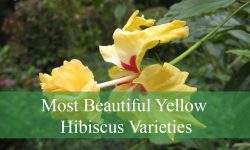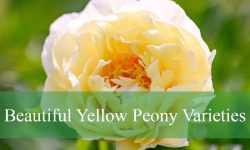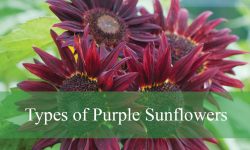Purple is a color often associated with elegance, mystery, and charm — and in the garden, it never fails to captivate. Whether you’re designing a border, creating a pollinator-friendly space, or adding a burst of color to your landscape, shrubs with purple flowers are an excellent choice. These plants offer not only stunning blooms but also structure, seasonal interest, and in many cases, delightful fragrance.
From vibrant lilacs and butterfly bushes to lesser-known beauties like Iochroma and Lespedeza, there’s an impressive variety of shrubs with purple flowers suited to gardens in North America, Europe, and beyond. These flowering shrubs range from compact ground-huggers to larger, statement-making bushes, ensuring there’s something for every size and style of garden.
In this guide, we’ll explore 40 gorgeous shrubs with purple flowers, complete with names, descriptions, and pictures to inspire your planting plans. Whether you’re a seasoned gardener or just starting out, these purple-flowering shrubs will add both beauty and biodiversity to your outdoor space.
Different Shrubs with Purple Flowers
Lilac (Syringa vulgaris)
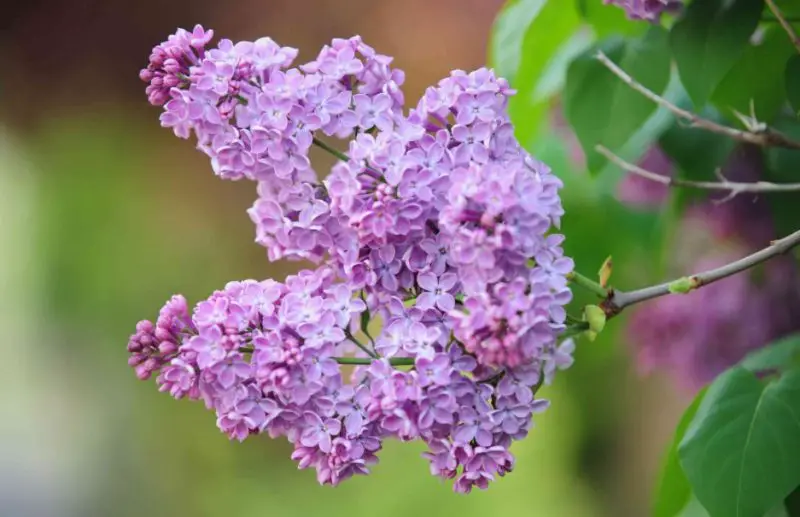
Lilac is a classic deciduous shrub celebrated for its fragrant, cone-shaped clusters of purple flowers that bloom in late spring. The blooms are highly aromatic, making them a favorite in cottage gardens and along walkways. They typically appear in shades ranging from pale lavender to deep purple.
This shrub has an upright, bushy form and grows up to 8–15 feet tall, depending on the variety. Its heart-shaped green leaves provide a lush backdrop during the growing season and turn yellow in the fall. Lilacs thrive in full sun and well-drained, neutral to slightly alkaline soil.
Syringa vulgaris is well-suited to colder climates and grows best in USDA hardiness zones 3 to 7. It benefits from cold winters, which help stimulate flower production. With proper pruning after blooming, lilacs can remain a long-lived and showy feature in the landscape.
Butterfly Bush (Buddleja davidii)
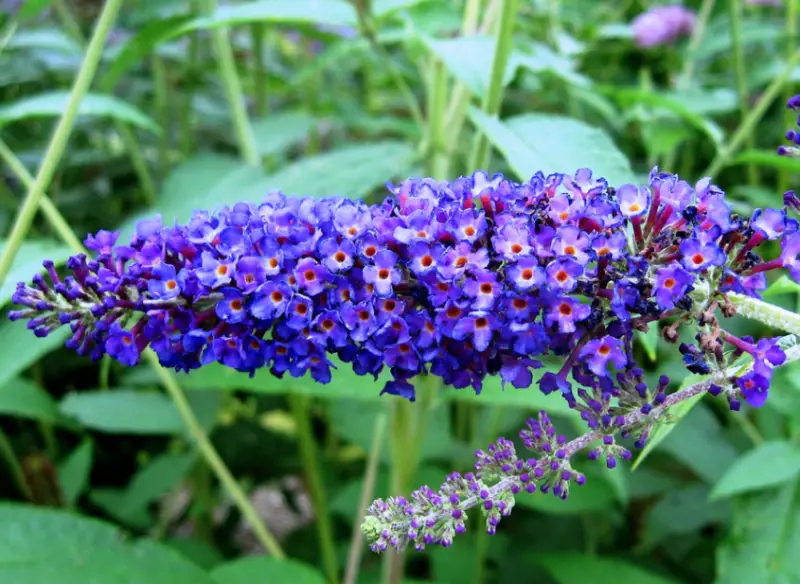
The Butterfly Bush is an arching, fast-growing deciduous shrub known for its striking, cone-shaped flower spikes in vibrant shades of purple. The flowers bloom continuously from mid-summer to early fall, attracting butterflies, bees, and hummingbirds in abundance—hence its name.
It typically grows 6 to 12 feet tall with long, lance-shaped gray-green leaves that provide a soft contrast to the vivid flower clusters. The shrub has a loose, fountain-like habit and can be pruned back in early spring to encourage bushier growth and better flowering.
Best suited to USDA hardiness zones 5 to 9, Buddleja davidii thrives in full sun and well-drained soil. It is drought-tolerant once established and is often used in pollinator gardens, borders, or as a flowering hedge.
Rose of Sharon (Hibiscus syriacus)
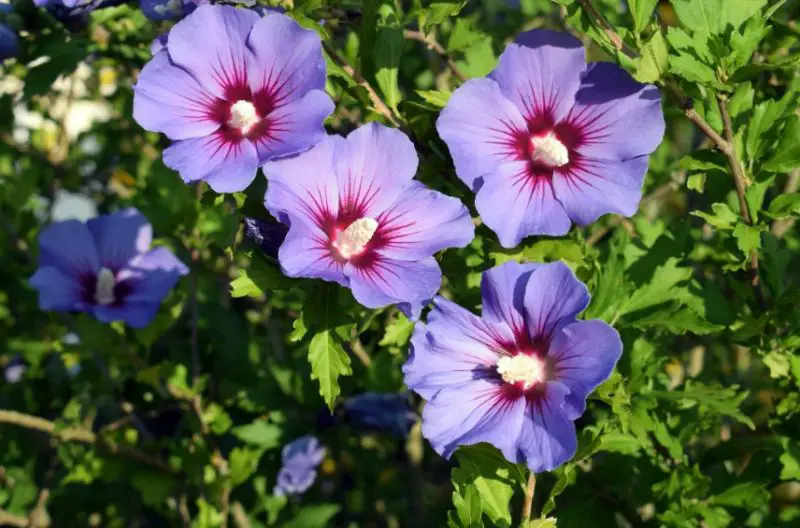
Rose of Sharon is a deciduous flowering shrub that produces large, showy purple to violet blooms in late summer through fall. The flowers are hibiscus-like in shape with a prominent central stamen and often have a darker throat. These blooms can reach up to 3 inches wide and appear continuously during the hot months.
This shrub typically grows 8 to 12 feet tall with a slightly upright, vase-shaped habit. It has lobed green leaves and tolerates a range of soil types, including clay. Rose of Sharon is easy to grow and makes a beautiful specimen or hedge plant.
Hibiscus syriacus is well-adapted to USDA hardiness zones 5 to 9. It enjoys full sun to partial shade and can tolerate urban conditions, drought, and heat. Its long blooming period and low maintenance make it a favorite in both formal and informal gardens.
Russian Sage (Perovskia atriplicifolia)
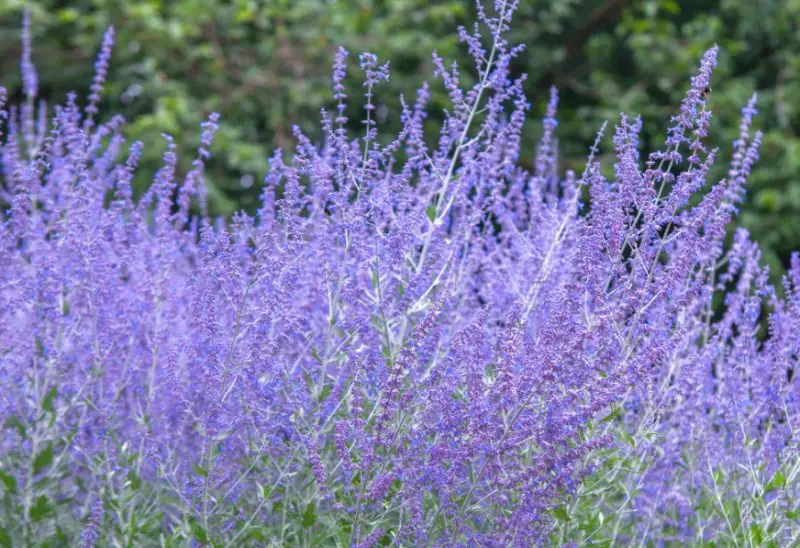
Russian Sage is a woody, aromatic subshrub known for its tall, airy sprays of lavender-blue flowers and silvery stems. The finely divided gray-green foliage gives the plant a soft, misty appearance that adds texture and movement to garden beds.
This perennial can reach 3 to 5 feet tall and wide, forming an open, bushy mound. The fragrant flowers bloom from midsummer through fall and are highly attractive to pollinators like bees and butterflies. Russian Sage pairs beautifully with ornamental grasses and drought-tolerant perennials.
Thriving in USDA hardiness zones 4 to 9, Perovskia atriplicifolia prefers full sun and well-drained soil. It is extremely heat and drought-tolerant once established, making it an excellent choice for xeriscapes and Mediterranean-style gardens.
Chaste Tree (Vitex agnus-castus)
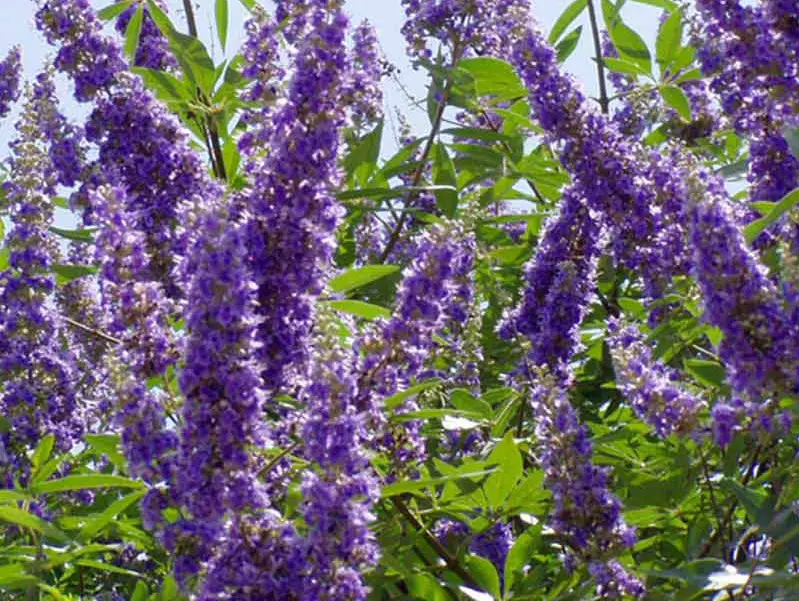
The Chaste Tree is a multi-stemmed deciduous shrub or small tree that produces upright spikes of aromatic purple flowers in mid to late summer. The blossoms resemble those of a butterfly bush and are beloved by pollinators, especially bees and butterflies.
It typically grows 8 to 15 feet tall and wide, with palmately divided, gray-green leaves that release a pleasant fragrance when brushed. The Chaste Tree has an elegant, spreading form and adds a Mediterranean flair to the landscape. It responds well to pruning and can be shaped as a large shrub or single-trunk tree.
Vitex agnus-castus thrives in USDA zones 6 to 9 and prefers full sun and well-drained soil. It is drought-tolerant, deer-resistant, and thrives in hot, dry climates, making it a popular choice in Southern gardens and urban landscapes.
Bluebeard (Caryopteris × clandonensis)

Bluebeard is a compact, deciduous shrub that produces small clusters of deep blue-violet flowers in late summer and early fall. These blossoms form along the upper stems and provide vital nectar for pollinators when many other plants are finished blooming.
The shrub typically grows 2 to 4 feet tall with a rounded habit and gray-green aromatic leaves that offer a pleasant scent when touched. Its tidy size makes it ideal for small gardens, borders, and foundation plantings. Some cultivars have variegated foliage for added interest.
Caryopteris × clandonensis grows well in USDA hardiness zones 5 to 9. It thrives in full sun and well-drained soil and tolerates drought once established. Bluebeard is a great low-maintenance option for late-season color in temperate gardens.
Purple Hebe (Hebe ‘Amy’, ‘Wiri Charm’, etc.)
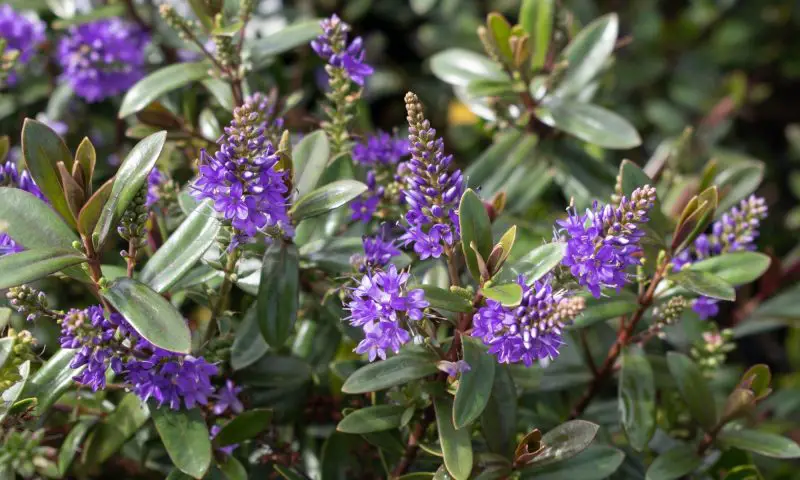
Purple Hebe is an evergreen shrub admired for its dense spikes of purple flowers that bloom during summer and into early fall. The flowers are tightly clustered and contrast beautifully with the glossy green or purplish-tinged foliage. Many cultivars, such as ‘Amy’ and ‘Wiri Charm’, are popular for their compact growth and vibrant color.
This shrub has a mounded form and usually grows 1 to 3 feet tall, making it perfect for borders, containers, and coastal gardens. The foliage remains attractive year-round, providing structure and color even when not in bloom. It’s also low maintenance and works well in mixed plantings.
Purple Hebe grows best in USDA hardiness zones 7 to 11, especially in the mild climates of Europe, the Pacific Northwest, or coastal California. It thrives in full sun to partial shade and prefers well-drained, slightly acidic soil. While tolerant of salt spray, it does not fare well in extreme cold.
Beautyberry (Callicarpa dichotoma)
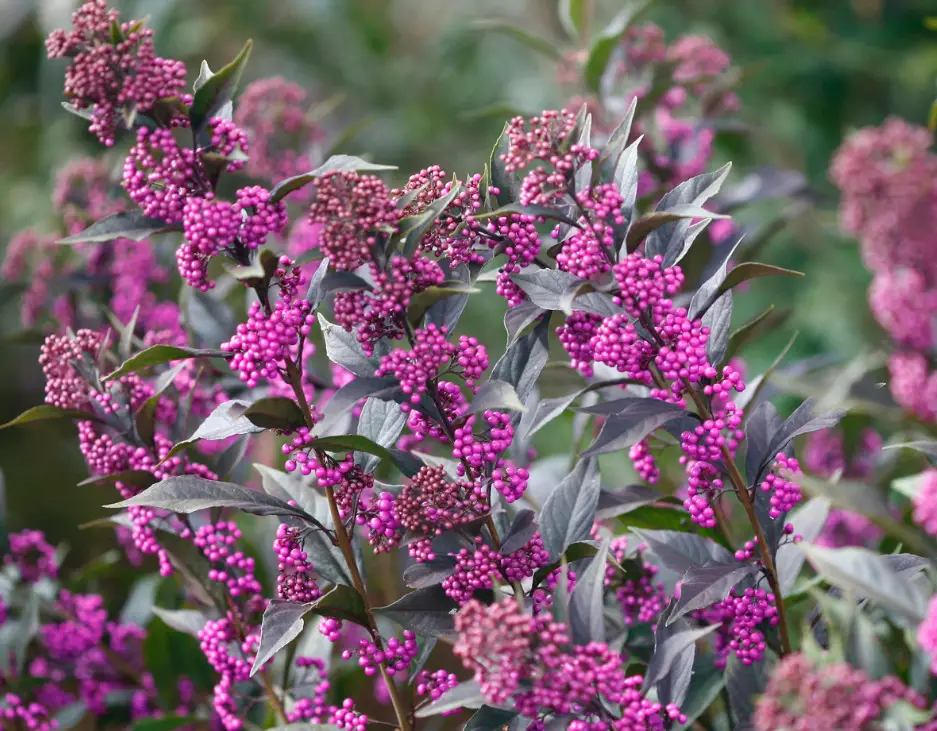
Beautyberry is a deciduous shrub best known for its eye-catching clusters of bright purple berries that appear in fall. Before the berries develop, the plant produces small pink to lavender flowers in summer, which attract pollinators. These blooms are delicate and form along the leaf axils on arching stems.
The shrub usually grows 3 to 6 feet tall with a graceful, spreading habit. Its light green foliage turns yellow in the fall, providing a colorful contrast to the vibrant berries that persist well into winter. Beautyberry is often used as a focal plant or in mass plantings for seasonal interest.
Callicarpa dichotoma thrives in USDA hardiness zones 5 to 8. It prefers full sun to partial shade and moist, well-drained soil. Once established, it is relatively drought-tolerant and requires minimal care, making it a great addition to wildlife gardens.
Lavender (Lavandula spp.)
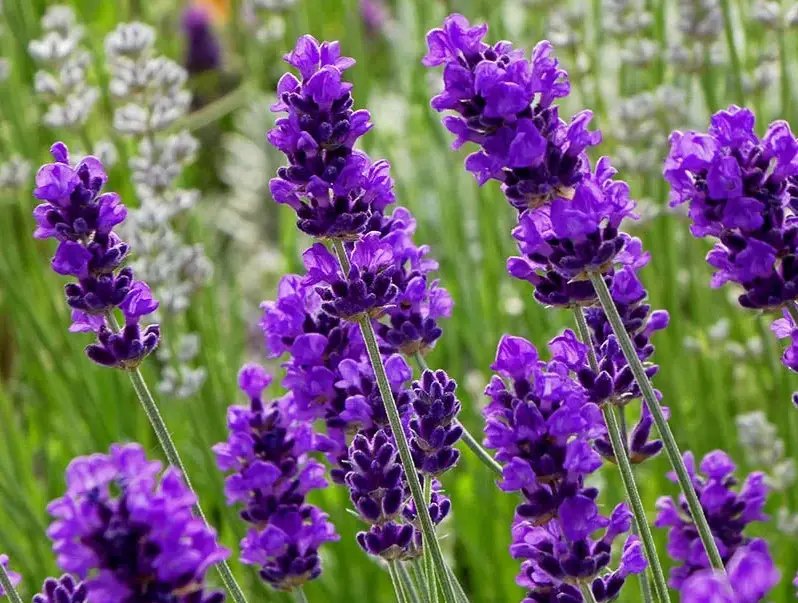
Lavender is a beloved evergreen subshrub known for its fragrant purple flower spikes and silvery-gray foliage. Blooming primarily in summer, its blooms are a favorite among bees, butterflies, and gardeners alike. The plant also provides essential oils used in aromatherapy and culinary applications.
Lavandula species typically grow 1 to 3 feet tall and have a rounded, bushy habit. Prized for its drought resistance and aromatic qualities, lavender works beautifully in herb gardens, borders, and rock gardens. The narrow, needle-like leaves remain attractive throughout the year.
Lavender is best suited to USDA hardiness zones 5 to 9, depending on the variety. It requires full sun and excellent drainage, as it does not tolerate soggy conditions. Once established, lavender is both deer-resistant and drought-tolerant, making it ideal for Mediterranean-style landscapes.
Hydrangea (Hydrangea macrophylla)
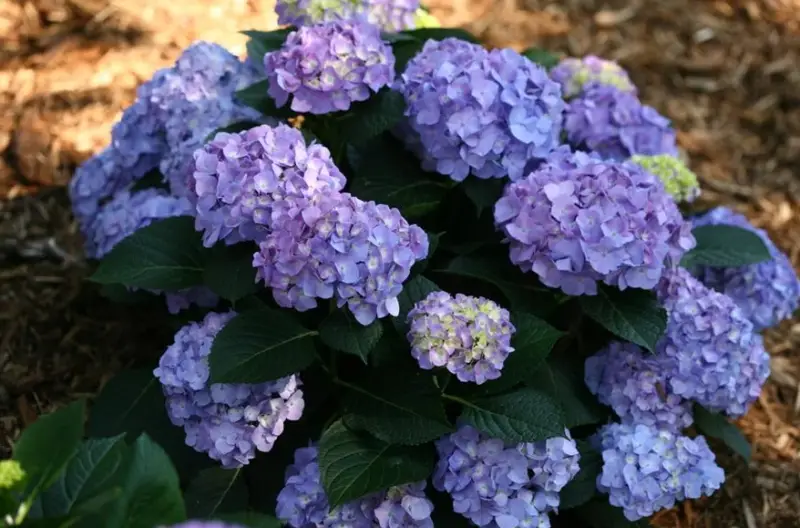
Hydrangea macrophylla is a deciduous shrub celebrated for its large, rounded flower clusters that can turn shades of purple depending on soil acidity. In acidic conditions, the blooms shift from pink to rich purple or blue, creating dramatic and colorful garden displays during summer.
This shrub typically grows 3 to 6 feet tall with a rounded shape and broad, serrated green leaves. Its showy flowers appear on both old and new wood, depending on the cultivar, and persist for weeks. Hydrangeas add elegance to borders, woodland gardens, and foundation plantings.
Suitable for USDA hardiness zones 5 to 9, Hydrangea macrophylla prefers partial shade and moist, well-drained soil. Regular watering and protection from harsh afternoon sun help maintain healthy blooms and foliage. Adjusting soil pH allows gardeners to manipulate flower color for stunning visual effects.
Wisteria frutescens
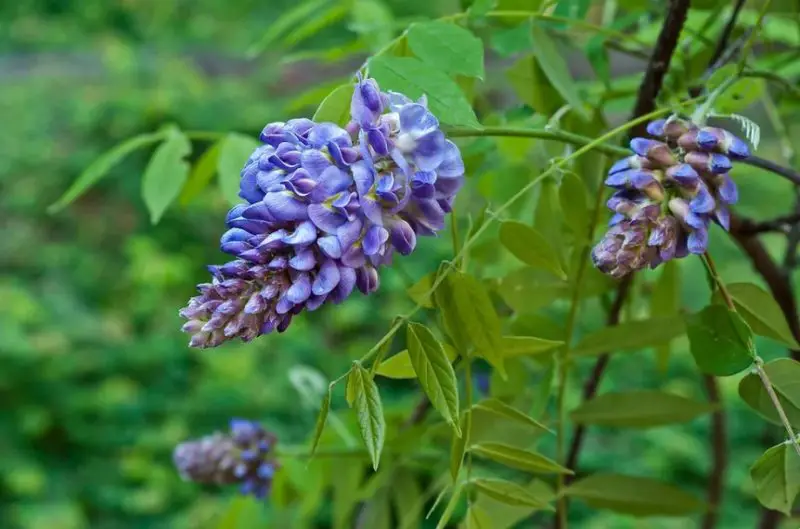
Wisteria frutescens is a North American native vine-like shrub known for its cascading clusters of fragrant purple flowers. Unlike its Asian cousins, this species is less aggressive and blooms later in the spring to early summer. The flowers form in dense, grape-like bunches that hang elegantly from twining stems.
This plant typically reaches 15 to 25 feet if supported but can also be pruned into a shrub form. Its bright green foliage adds a lush backdrop during the growing season, and its flowers are known to attract bees and butterflies. Wisteria frutescens is especially useful in native gardens or trained on trellises and arbors.
Hardy in USDA zones 5 to 9, it thrives in full sun and moist, well-drained soil. Unlike the invasive Chinese and Japanese wisterias, this native species is well-behaved and manageable in temperate gardens. Regular pruning encourages more blooms and helps control its growth habit.
Ceanothus ‘Dark Star’ (California Lilac)
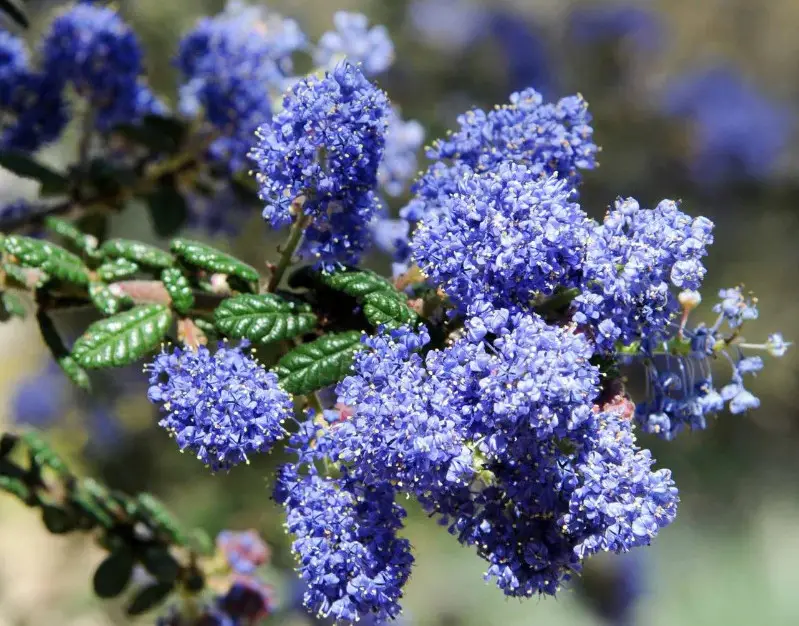
Ceanothus ‘Dark Star’ is an evergreen shrub admired for its profusion of deep bluish-purple flowers that bloom in spring. The tiny, star-like flowers cluster densely along the branches, creating a striking display against the plant’s dark green, finely textured foliage. It is a standout variety of the California Lilac group.
This shrub grows 4 to 8 feet tall and wide with a compact, mounding shape. It provides excellent habitat for pollinators and birds and works well in drought-tolerant or Mediterranean-style landscapes. Its glossy leaves remain attractive year-round, giving the garden color even after flowering ends.
‘Dark Star’ is best suited for USDA hardiness zones 8 to 10 and thrives in dry, sunny locations with well-drained soil. It requires little to no supplemental water once established and performs best in regions with mild winters and hot, dry summers. Avoid overwatering or heavy soil to prevent root rot.
Rhododendron spp.
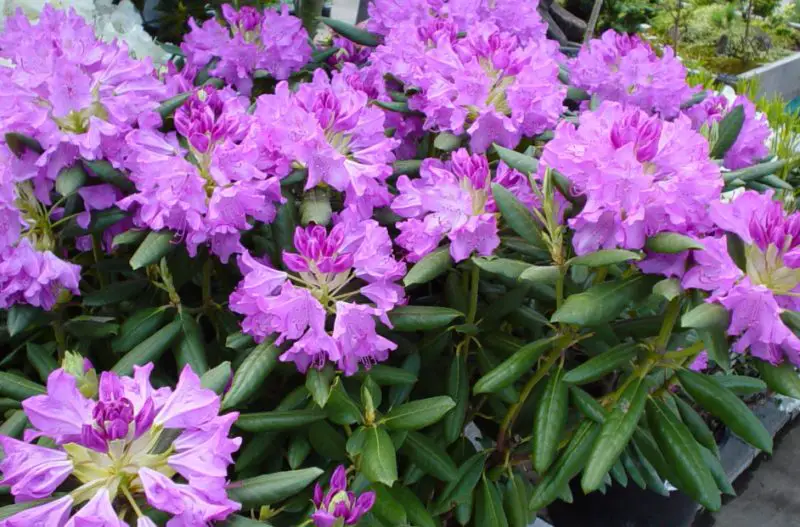
Rhododendrons are broadleaf evergreen or deciduous shrubs known for their large, showy flower clusters, many of which appear in shades of purple. These plants are a staple in woodland and shade gardens, especially in cooler climates. Their thick, leathery leaves offer year-round structure when not in bloom.
With hundreds of species and hybrids, Rhododendrons range in size from compact dwarf varieties to large shrubs reaching over 10 feet tall. The purple-flowered types are especially prized for their vivid spring displays, which often contrast beautifully with the plant’s deep green foliage.
Best grown in USDA hardiness zones 4 to 8, Rhododendrons prefer acidic, well-drained soil and filtered sunlight. They thrive in cool, moist environments and benefit from mulching and protection from strong winds. Avoid planting them in heavy clay or overly alkaline soil.
Azalea (deciduous and evergreen)
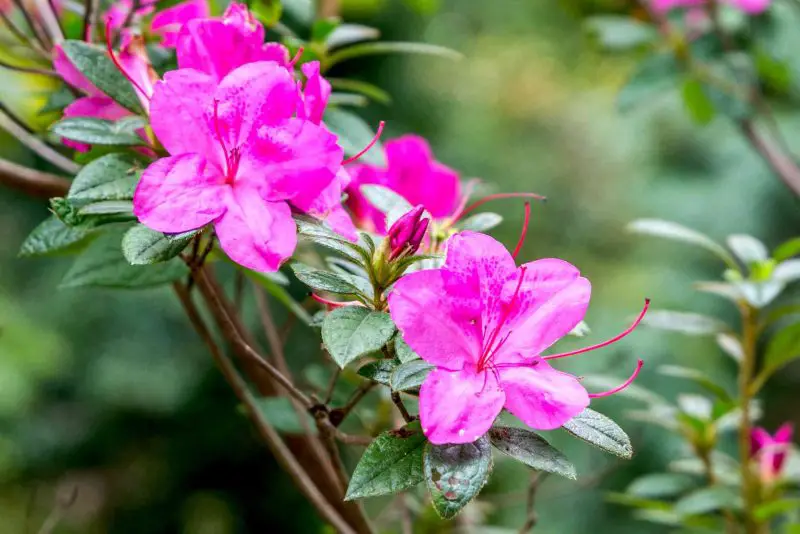
Azaleas are part of the Rhododendron genus and include both evergreen and deciduous types, with numerous hybrids featuring purple, lavender, or violet blossoms. Blooming in spring, and sometimes again in fall, their funnel-shaped flowers cover the plant in a dazzling display.
These shrubs are generally smaller than traditional Rhododendrons, often ranging from 2 to 5 feet tall. Deciduous azaleas offer the bonus of fall foliage color, while evergreen varieties provide year-round greenery. Their compact size and vibrant blooms make them ideal for borders and foundation plantings.
Azaleas thrive in USDA hardiness zones 6 to 9 and prefer acidic, well-drained soil. Partial shade is ideal, though they can tolerate more sun in cooler climates. Regular watering, especially during bloom time, helps ensure vibrant flowers and healthy growth.
Duranta erecta ‘Sapphire Showers’
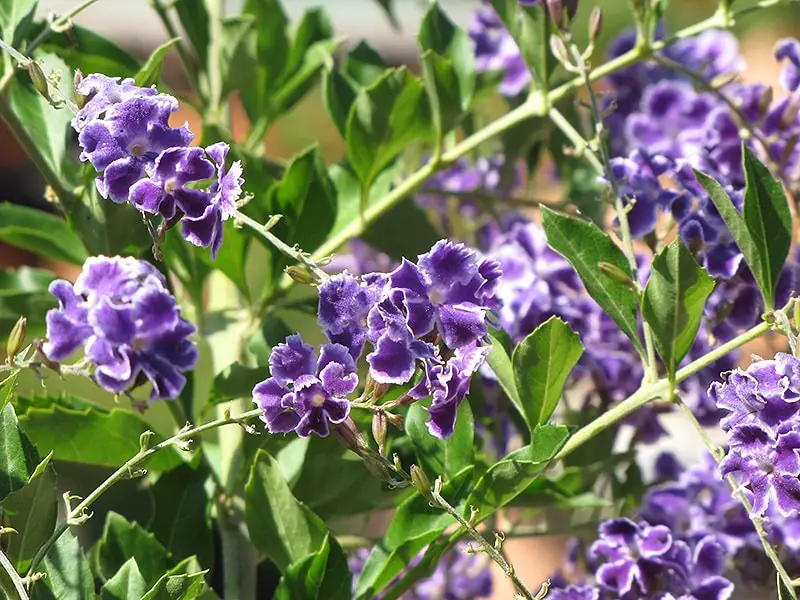
Duranta erecta ‘Sapphire Showers’ is a tropical to subtropical shrub adorned with cascading violet-blue flowers that resemble small orchids. Its trailing blooms appear from spring through fall and are often accompanied by golden-yellow berries, adding additional ornamental appeal.
This fast-growing shrub can reach up to 10 feet tall and wide in warm climates. It has arching stems with slightly spiny branches and light green foliage. While evergreen in warm areas, it may be grown as an annual or container plant in cooler regions and overwintered indoors.
Ideal for USDA hardiness zones 9 to 11, ‘Sapphire Showers’ thrives in full sun and well-drained soil. It performs best with regular watering and fertilization during the growing season. In warm climates, it attracts butterflies and hummingbirds, making it a popular landscape choice.
Verbena rigida
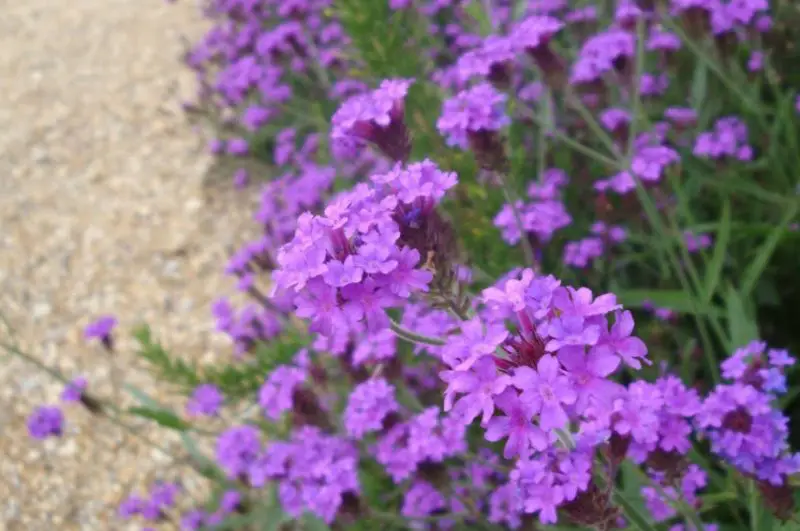
Verbena rigida is a low-growing, woody perennial or subshrub with clusters of densely packed, purple to violet flowers. It blooms from late spring through fall and is known for its ability to spread quickly, making it a great groundcover in sunny gardens.
This plant typically grows up to 1 to 2 feet tall and forms a spreading mat of rough, lance-shaped foliage. The vibrant flowers are magnets for butterflies and bees and create an eye-catching carpet of color in mixed beds and borders.
Best suited to USDA hardiness zones 7 to 10, Verbena rigida prefers full sun and well-drained soil. It tolerates heat and drought once established and benefits from occasional deadheading to prolong blooming. This easy-care shrub is perfect for low-maintenance and pollinator-friendly gardens.
Teucrium fruticans (Shrubby Germander)
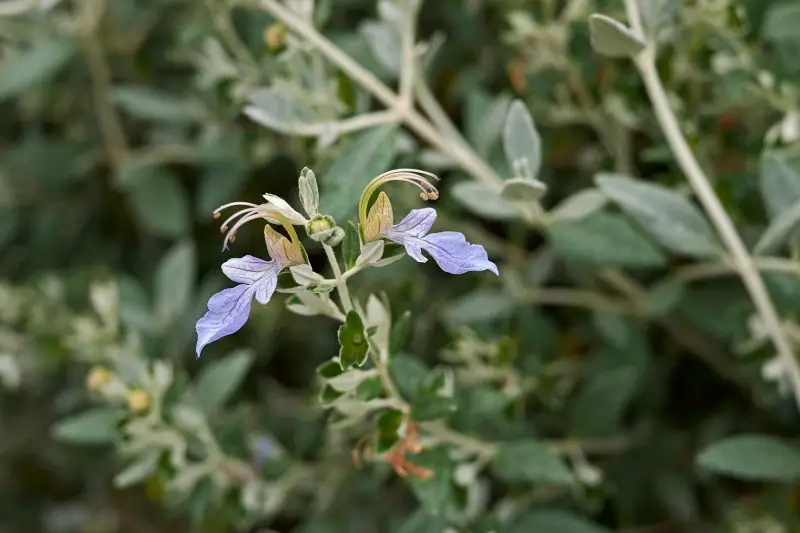
Teucrium fruticans, or Shrubby Germander, is an evergreen shrub featuring aromatic, silvery-gray foliage and delicate lavender-blue flowers. Blooming throughout summer, it adds subtle color and striking foliage contrast to Mediterranean and dry gardens.
Growing up to 3 to 6 feet tall and wide, this shrub has a compact, rounded habit with softly arching branches. The tiny flowers appear along the stems and are highly attractive to pollinators. Its silvery leaves add brightness to the garden and look beautiful year-round.
Hardy in USDA zones 7 to 10, Shrubby Germander prefers full sun and well-drained, even rocky soil. It is drought-tolerant and thrives with minimal water, making it ideal for xeriscapes and low-maintenance borders. Light pruning helps maintain its shape and encourages more blooms.
Iochroma cyaneum
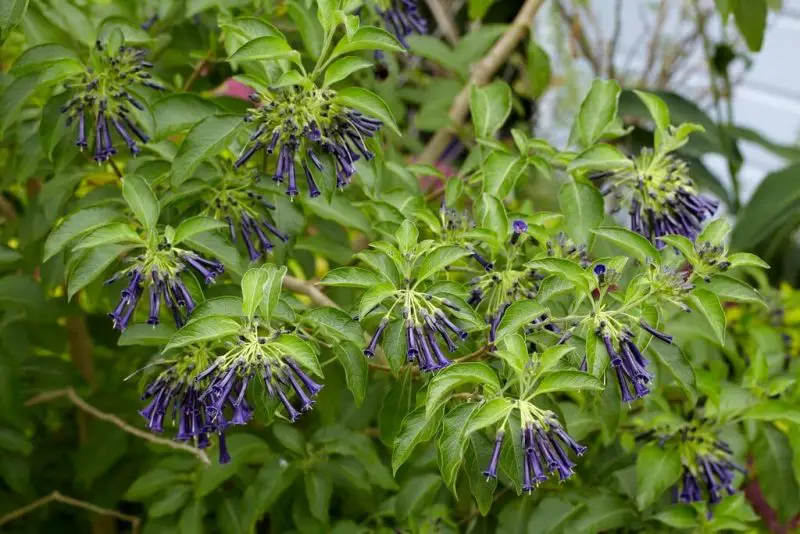
Iochroma cyaneum is a subtropical shrub admired for its tubular purple flowers that hang in clusters like bells. These vivid blooms appear from late spring through fall and are especially attractive to hummingbirds and butterflies, lending an exotic flair to mild-climate gardens.
This shrub can grow 6 to 10 feet tall with an open, bushy habit and soft green foliage. While it has a tropical appearance, Iochroma is grown ornamentally in Europe and parts of the United States where winters are mild. Its striking flowers and fast growth make it a standout.
Iochroma cyaneum performs best in USDA zones 9 to 11, thriving in full sun to partial shade and well-drained soil. In cooler climates, it can be grown in containers and overwintered indoors. Regular pruning encourages more compact growth and continuous flowering.
Tibouchina urvilleana (Princess Flower)
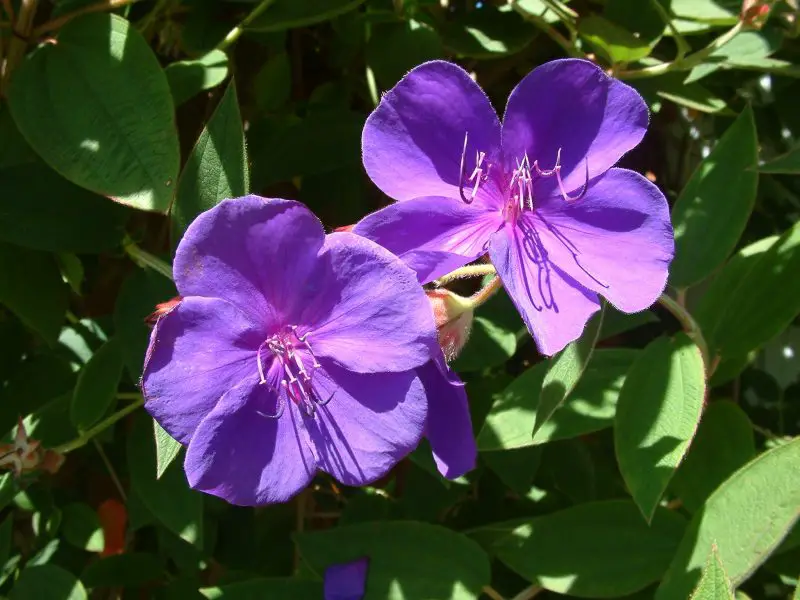
Tibouchina urvilleana, commonly known as Princess Flower, is a tropical shrub treasured for its vivid, royal purple blossoms. The flowers are large and velvety, appearing from summer into fall, and contrast beautifully against the rich green, slightly fuzzy foliage.
This fast-growing plant can reach heights of 6 to 10 feet and features a sprawling, bushy growth habit. While it’s a perennial in warm climates, gardeners in cooler regions often grow it in containers and overwinter it indoors to protect it from frost.
Hardy in USDA zones 9 to 11, Tibouchina thrives in full sun to partial shade and prefers moist, well-draining soil. It benefits from regular watering and light pruning to maintain shape and encourage more blooms. Its striking appearance makes it a standout in subtropical and tropical landscapes.
Plectranthus ‘Mona Lavender’
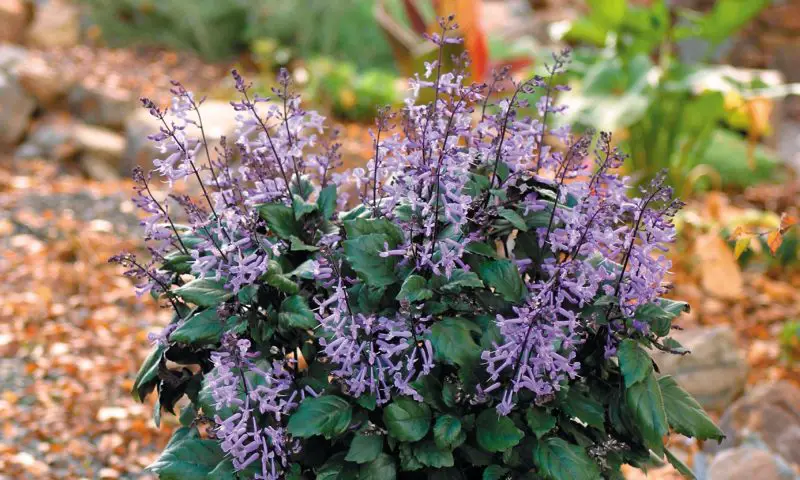
Plectranthus ‘Mona Lavender’ is an ornamental shrub prized for both its attractive foliage and tubular lavender-purple flowers. The blooms appear in upright spikes above deep green leaves with vibrant purple undersides, offering visual interest even when the plant isn’t flowering.
It typically grows 1 to 2 feet tall and wide, making it ideal for containers, borders, and shaded garden areas. Unlike many Plectranthus varieties, ‘Mona Lavender’ prefers more light and produces its best floral displays in bright indirect light or partial sun.
This plant is hardy in USDA zones 9 to 11 but is commonly grown as an annual or houseplant in cooler climates. It prefers well-drained soil, moderate watering, and benefits from occasional pruning to encourage bushiness and more flowers throughout the season.
Salvia ‘Mystic Spires Blue’
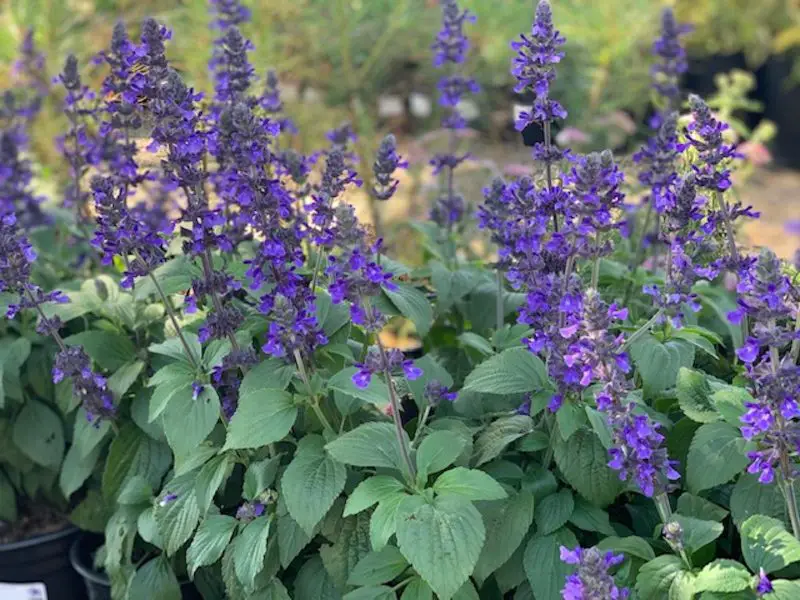
Salvia ‘Mystic Spires Blue’ is a compact, shrubby salvia that features striking purple-blue flower spikes throughout summer and into fall. The flowers are densely packed along tall stems, attracting bees, butterflies, and hummingbirds.
This cultivar reaches about 2 to 3 feet tall and maintains a tidy, mounded shape, making it a favorite for borders, cottage gardens, and pollinator-friendly landscapes. Its vibrant color and long bloom season provide excellent contrast in mixed perennial beds.
It grows best in USDA zones 7 to 10 and prefers full sun and well-drained soil. Mystic Spires is drought-tolerant once established and benefits from deadheading to prolong blooming. It’s also deer-resistant, adding to its appeal in suburban and rural settings.
Calamintha nepeta
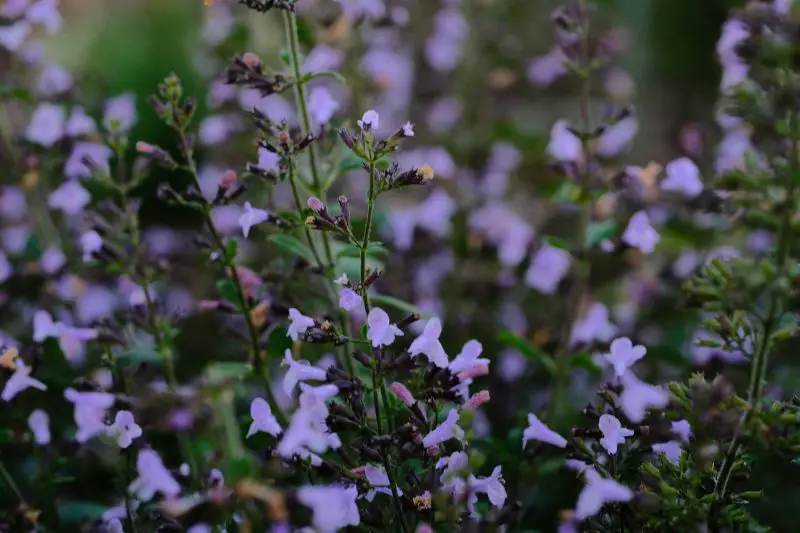
Calamintha nepeta, also known as lesser calamint, is a low-maintenance subshrub that produces clouds of tiny violet-blue flowers from early summer into fall. These delicate blooms are beloved by pollinators, especially bees and butterflies.
This plant forms a tidy mound 12 to 24 inches tall and wide, with aromatic, minty-scented foliage that contributes to its charm. Though its flowers are small, they appear in such abundance that the plant often looks like it’s shimmering with color.
Hardy in USDA zones 4 to 9, Calamintha thrives in full sun and well-drained soil. It is drought-tolerant and thrives with little care, making it perfect for rock gardens, herb borders, and other sunny, dry locations. Light pruning after the first bloom flush can encourage reblooming.
Syringa meyeri ‘Palibin’ (Dwarf Korean Lilac)
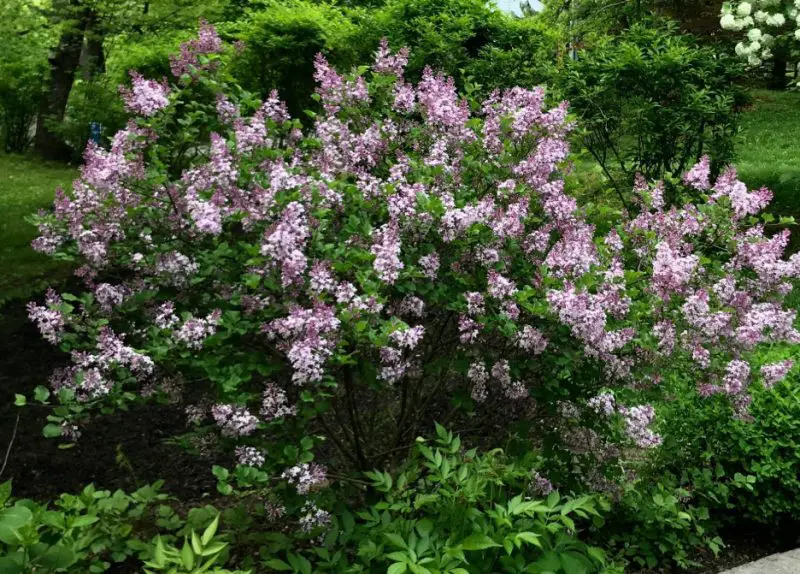
Syringa meyeri ‘Palibin’, or Dwarf Korean Lilac, is a compact lilac variety that bursts into bloom with fragrant, lavender-purple flowers in late spring to early summer. Its smaller size makes it a great alternative to traditional lilacs in limited garden spaces.
This deciduous shrub typically grows 4 to 5 feet tall and wide, forming a dense, rounded mound. Its leaves are smaller than those of common lilacs, and it has a more refined, uniform growth habit that requires little pruning.
Ideal for USDA zones 3 to 7, ‘Palibin’ prefers full sun and well-drained, slightly alkaline soil. It’s cold-hardy and very low maintenance, making it a reliable choice for hedges, borders, or foundation plantings. Occasional deadheading helps maintain a neat appearance.
Vitex trifolia
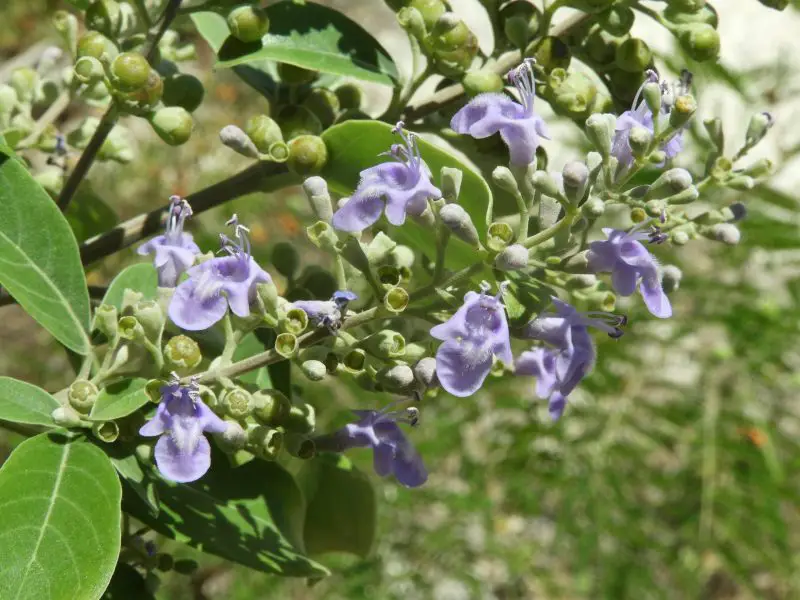
Vitex trifolia is a tropical to subtropical shrub or small tree that is relatively rare in temperate landscapes but found in coastal parts of southern Europe and warm U.S. regions. Its pale violet to bluish-purple flower spikes appear through summer and fall.
This species typically reaches 6 to 10 feet tall and is noted for its striking three-lobed leaves, which are gray-green on top and silvery underneath. The flowers are lightly fragrant and attract butterflies and bees, while the foliage offers year-round texture.
Best suited to USDA zones 9 to 11, Vitex trifolia prefers full sun and well-drained soil. It thrives in hot, humid environments and tolerates salt spray, making it an excellent option for coastal gardens. Light pruning after flowering helps maintain shape and encourages fuller growth.
Scaevola aemula (Fan Flower)
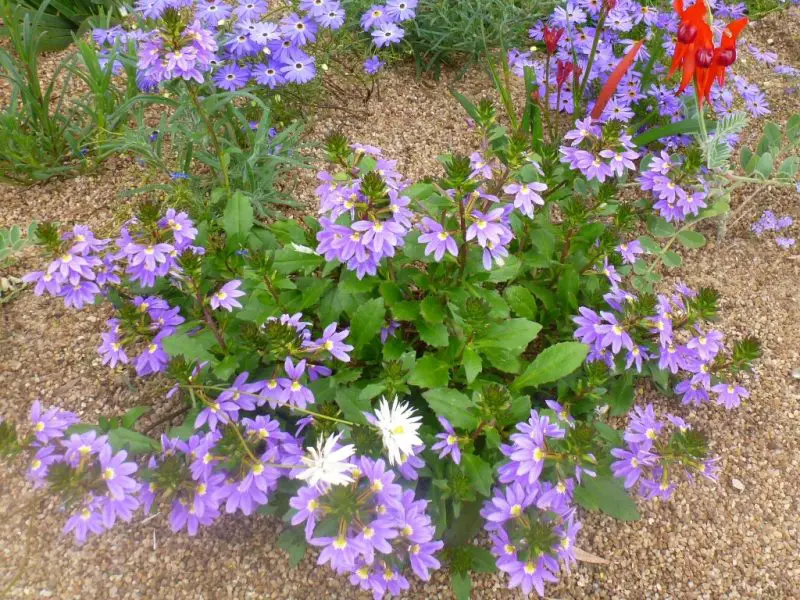
Scaevola aemula, commonly known as Fan Flower, is a semi-woody perennial subshrub native to Australia and admired for its unique, fan-shaped purple blooms. The flowers appear along trailing stems and bloom continuously from late spring to fall, especially in warm climates.
This plant typically grows 8 to 12 inches tall and spreads up to 2 feet wide, making it a great option for hanging baskets, containers, and sunny ground covers. Its lush green foliage complements the abundant purple blossoms, giving a full and flowing appearance.
Best suited to USDA zones 9 to 11, Scaevola thrives in full sun and well-draining soil. It is heat-tolerant, drought-resistant once established, and requires minimal maintenance aside from occasional deadheading to encourage continued blooming.
Browallia americana
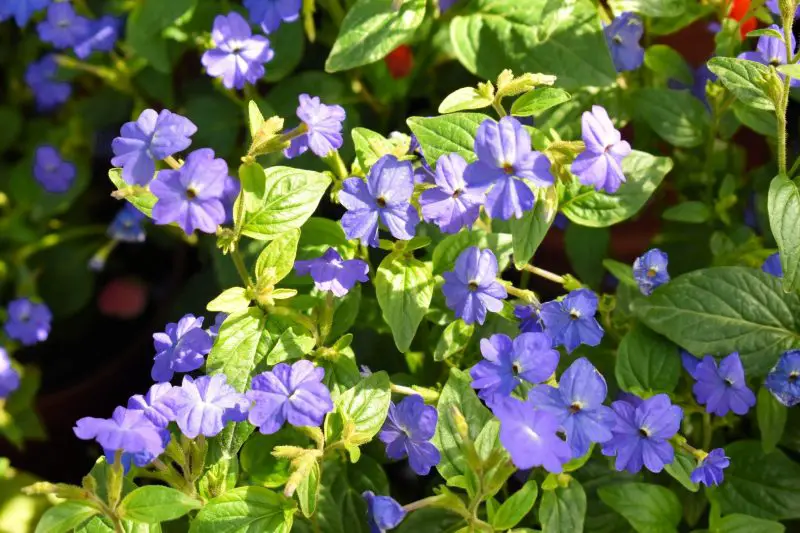
Browallia americana is a tender, bushy shrub often grown as an annual or short-lived perennial in warm, frost-free regions. It produces star-shaped, bluish-purple flowers that resemble small petunias and can bloom continuously in ideal conditions.
It grows about 1 to 2 feet tall and wide and is popular for shady borders, mixed containers, or underplanting taller shrubs. The soft green foliage provides a fine-textured backdrop to its cheerful purple blooms, creating a light, airy look.
Suitable for USDA zones 10 to 11, Browallia thrives in partial shade and moist, well-drained soil. It prefers regular watering and benefits from pinching back to encourage bushier growth. While it’s tender, it offers a lush, tropical appearance with minimal effort.
Thymus vulgaris (Thyme)
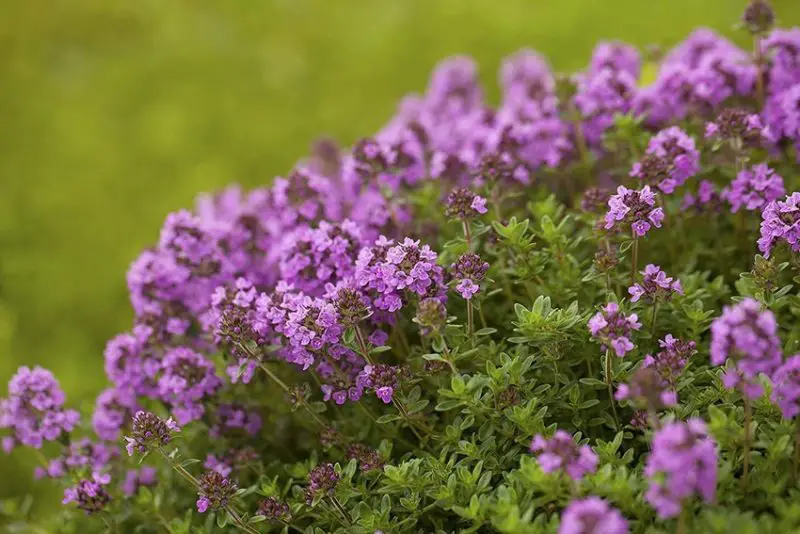
Thymus vulgaris, or common thyme, is primarily known as a culinary herb, but it also serves as a semi-woody ornamental subshrub with small, tubular purple to lavender flowers. The blooms appear in late spring to early summer and attract bees and butterflies.
This low-growing plant reaches about 6 to 12 inches in height, spreading gradually across dry, sunny spaces. Its aromatic leaves are evergreen in mild climates and create a dense mat of greenery that’s perfect for edging paths or filling rock gardens.
Hardy in USDA zones 5 to 9, thyme prefers full sun and sandy, well-drained soil. It thrives in dry, poor soils and is drought-tolerant once established. Light pruning after flowering keeps the plant neat and encourages fresh, fragrant growth.
Nepeta × faassenii (Catmint)
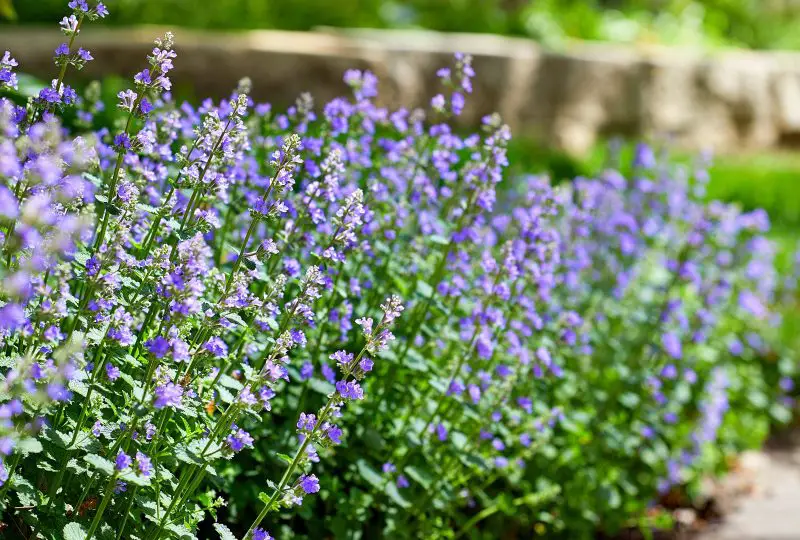
Nepeta × faassenii, commonly called Catmint, is a long-blooming, clump-forming subshrub known for its aromatic foliage and soft bluish-purple flower spikes. The flowers bloom from late spring through summer and are adored by bees, butterflies, and cats alike.
This plant forms tidy mounds about 12 to 24 inches tall and wide, making it ideal for borders, walkways, or cottage gardens. Its gray-green leaves provide a lovely contrast to the vibrant flower spikes and emit a minty aroma when brushed.
Hardy in USDA zones 4 to 9, Catmint thrives in full sun and well-drained soil. It tolerates drought, poor soil, and deer, making it a low-maintenance choice for gardeners. Cutting it back after the first bloom often encourages a fresh flush of flowers.
Daphne cneorum (Garland Daphne)
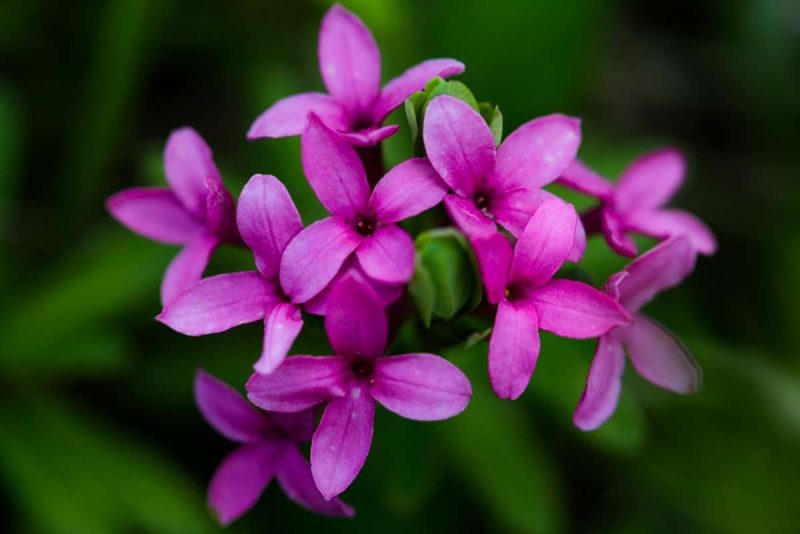
Daphne cneorum, or Garland Daphne, is a low-growing, evergreen to semi-evergreen shrub that blooms profusely in early to mid-spring with clusters of fragrant pink to lavender-pink flowers. Its blossoms are small but very showy and intensely aromatic.
This compact plant typically reaches only 6 to 12 inches in height and spreads 1 to 2 feet wide. Its glossy, dark green foliage forms a neat, rounded shape that adds year-round interest, especially when planted near walkways or entrances where the scent can be enjoyed.
Suited for USDA zones 4 to 8, Daphne cneorum prefers partial sun to light shade and well-drained, slightly alkaline soil. Though it requires careful placement and dislikes root disturbance, it rewards with exceptional beauty and fragrance when established.
Hebe ‘Purple Shamrock’
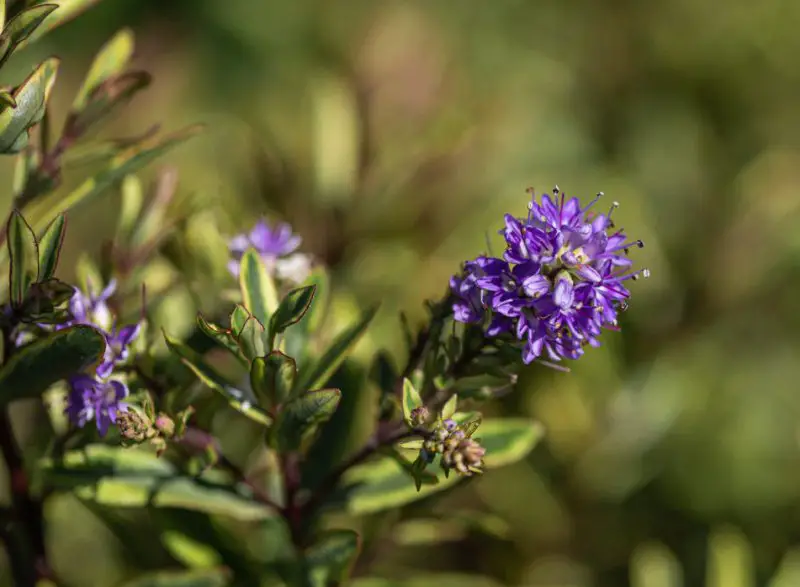
Hebe ‘Purple Shamrock’ is an eye-catching evergreen shrub featuring deep purple foliage and small violet flowers that bloom in clusters during summer. The leaf color intensifies in cool weather, adding extra visual interest in seasonal gardens.
It typically grows 12 to 24 inches tall and wide, forming a rounded, compact shape that fits well in borders, containers, and small-space gardens. Its striking foliage makes it valuable even when not in bloom, offering bold contrast among green-leaved plants.
Best suited for USDA zones 8 to 10, Hebe ‘Purple Shamrock’ thrives in full sun to partial shade and prefers moist, well-drained soil. It enjoys a mild climate and benefits from occasional pruning to maintain its shape and encourage dense growth.
Melastoma malabathricum (Indian Rhododendron)
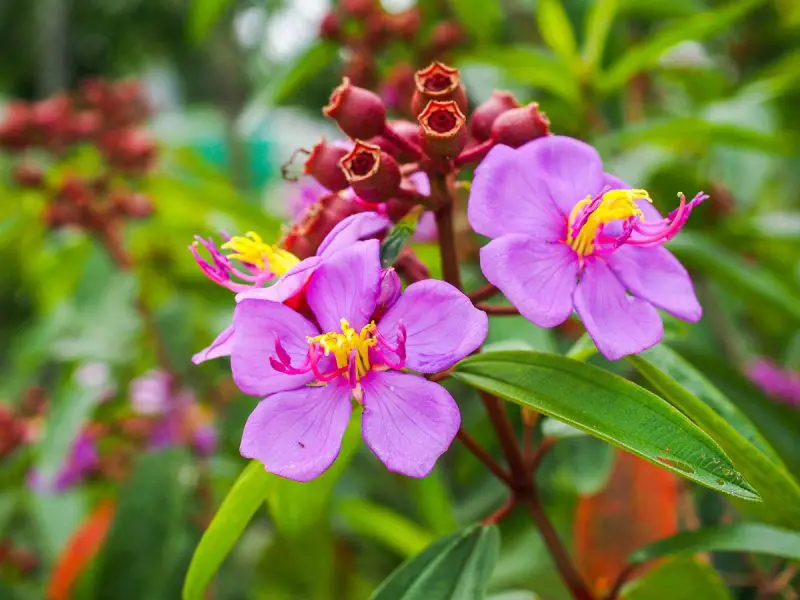
Melastoma malabathricum, commonly known as Indian Rhododendron or Singapore Rhododendron, is a tropical shrub admired for its striking purple-pink flowers. Although not widely used in landscaping outside its native range, it is occasionally grown in botanical gardens and specialty collections for its ornamental appeal.
This shrub can grow up to 10 feet tall and features soft, velvety leaves with pronounced veins. Its blooms have five large petals and prominent yellow stamens, making them highly decorative and attractive to pollinators.
Best suited to USDA zones 9 to 11, Indian Rhododendron thrives in warm, humid climates and prefers acidic, well-drained soils. It requires full sun to partial shade and benefits from regular moisture to flourish in ornamental tropical settings.
Lespedeza thunbergii (Bush Clover)
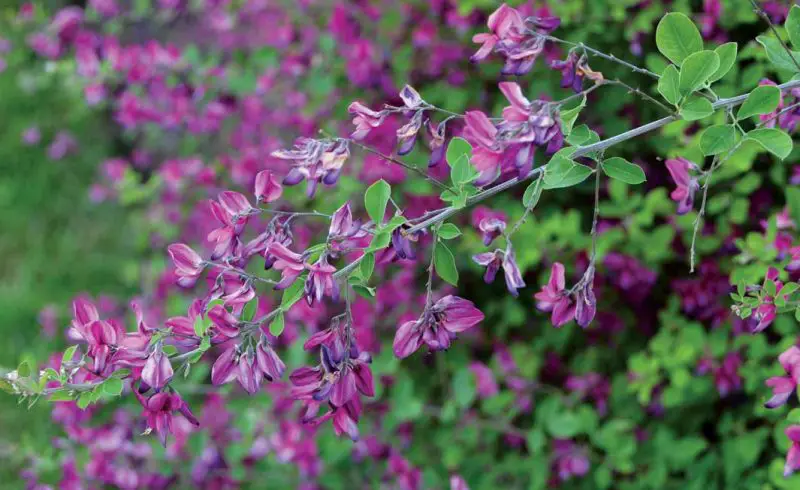
Lespedeza thunbergii, or Bush Clover, is a graceful, deciduous shrub known for its arching stems covered in small, pea-like flowers that range in color from purple to pink. It adds movement and soft texture to the garden from late summer into fall.
Typically reaching 4 to 6 feet in height and spread, it creates a fountain-like form that looks particularly striking on slopes or cascading over walls. Its trifoliate leaves add interest even when the plant is not in bloom.
Hardy in USDA zones 4 to 8, this shrub prefers full sun and well-drained soils. It is drought-tolerant once established and can be cut back hard in late winter to encourage fresh, vigorous growth and abundant blooms each season.
Symphytum × uplandicum (Comfrey)
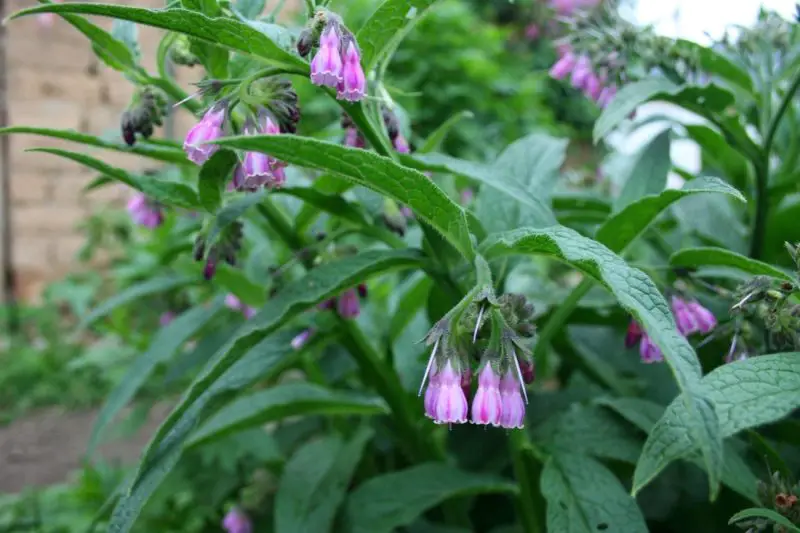
Symphytum × uplandicum, commonly known as Russian Comfrey or Upland Comfrey, is a herbaceous perennial with medicinal uses and ornamental value. It produces drooping clusters of tubular purple or blue flowers in late spring and early summer.
The plant grows 2 to 3 feet tall and features large, coarse leaves that provide a lush, textured look. Its deep taproots make it useful for improving soil, while its flowers attract bees and other beneficial insects.
Hardy in USDA zones 4 to 9, Comfrey thrives in full sun to partial shade and moist, fertile soil. Once established, it requires minimal care and can be used in permaculture gardens, pollinator beds, or as a companion plant near fruit trees.
Dalea purpurea (Purple Prairie Clover)

Dalea purpurea, or Purple Prairie Clover, is a native North American subshrub known for its vibrant, cylindrical flower heads made up of tiny purple florets. This plant blooms in mid to late summer and supports pollinators, especially bees and butterflies.
Reaching 1 to 3 feet in height, Purple Prairie Clover has delicate, fern-like foliage and a deep taproot, making it both visually appealing and resilient. Its upright form and fine texture suit wildflower meadows, prairie gardens, and native plantings.
Ideal for USDA zones 3 to 8, this hardy plant prefers full sun and well-drained soil. It is highly drought-tolerant, deer-resistant, and thrives in tough conditions, contributing both beauty and ecological value to dry landscapes.
Lagerstroemia indica ‘Purple Magic’ (Crape Myrtle)
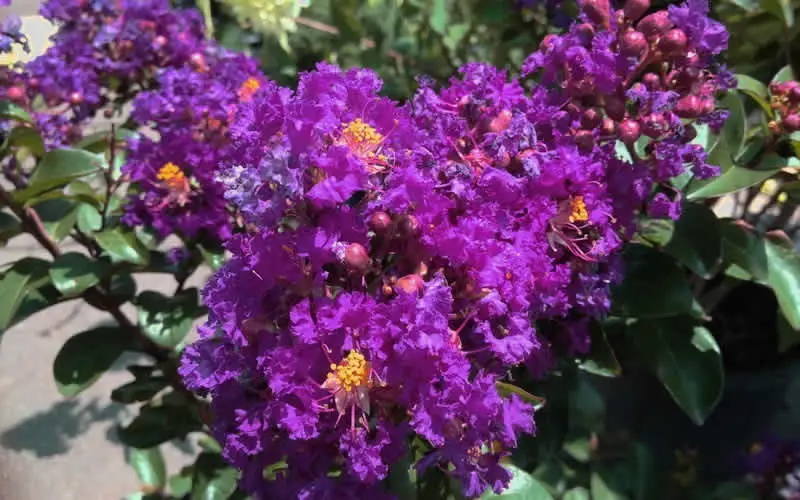
Lagerstroemia indica ‘Purple Magic’ is a compact, deciduous shrub variety of Crape Myrtle that boasts rich, deep purple flower clusters. Blooming profusely in mid to late summer, it provides a splash of color when many other plants begin to fade.
This cultivar grows about 6 to 10 feet tall and wide, forming a rounded shape ideal for foundation plantings, hedges, or accent borders. Its dark green foliage sometimes takes on reddish tones in fall, adding seasonal interest.
Hardy in USDA zones 6 to 9, ‘Purple Magic’ prefers full sun and well-drained soil. It is heat- and drought-tolerant once established and benefits from annual pruning in late winter to promote stronger, more floriferous new growth.
Campanula portenschlagiana (Dalmatian Bellflower)
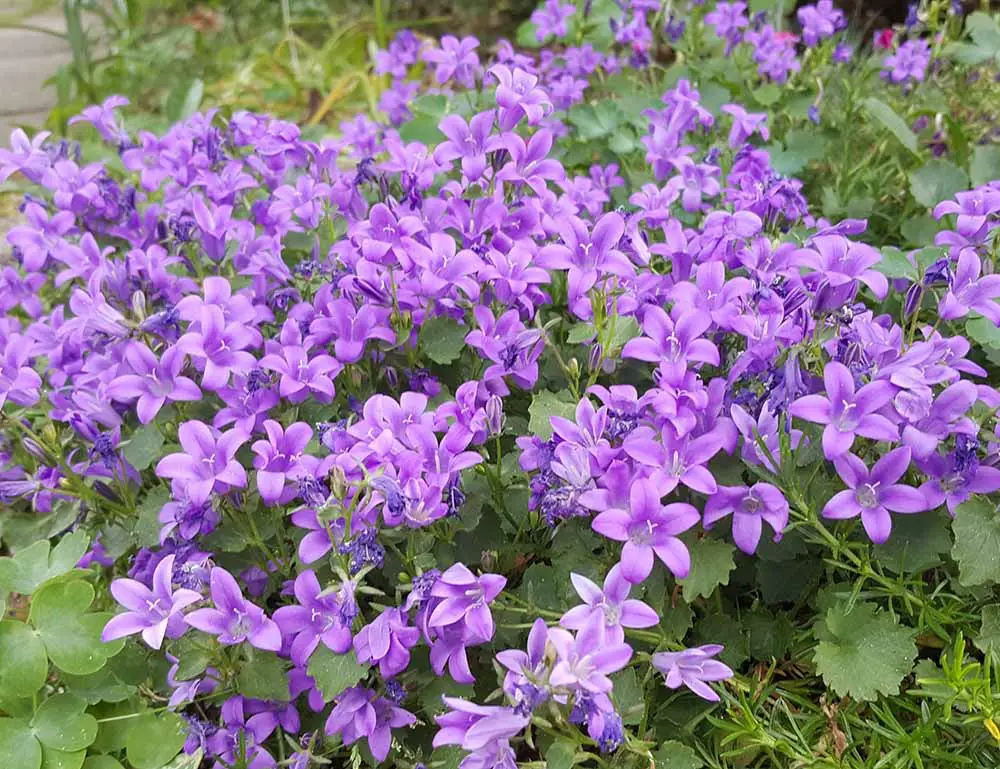
Campanula portenschlagiana, known as Dalmatian Bellflower, is a low-growing, mound-forming perennial often used as a ground cover. Its vivid purple, star-shaped flowers bloom profusely from late spring through summer, creating a carpet of color.
Typically only 4 to 6 inches tall but spreading widely, this plant hugs the ground and spills attractively over rock walls, borders, and containers. Its small, rounded leaves remain evergreen in mild climates, offering texture year-round.
Hardy in USDA zones 3 to 8, Dalmatian Bellflower prefers full sun to partial shade and well-drained soil. It tolerates poor soils and light foot traffic, making it a versatile and reliable option for alpine gardens or low-maintenance edging.


